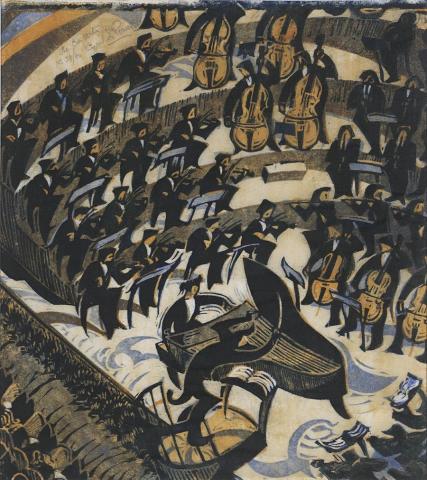THE CONCERTO, c.1935
CYRIL POWER
colour linocut on oriental tissue
33.0 x 29.0 cm
signed, titled and numbered upper left: The Concerto / No 34/60 / Cyril. E. Power
DC Art, Sydney
Private collection, Sydney
Colour prints – [and] Monotypes and Carvings by Elizabeth Spurr, Redfern Gallery, London, 11 July – 3 August 1935, cat. 17 (another example)
Rhythms of Modern Life: British Prints 1914–1939, Museum of Fine Arts, Boston, 30 January – 1 June 2008; Metropolitan Museum of Art, New York, 23 September – 14 December 2008; and Wolfsonian-Florida International University, Miami, 21 November 2009 – 28 February 2010, cat. 86 (another example)
Grosvenor School Prints, DC Art, Sydney, 1988
Coppel, S., Linocuts of the Machine Age: Claude Flight and the Grosvenor School, Scolar Press, Aldershot, England, in association with the National Gallery of Australia, 1995, p. 103, cat. CEP 43, p. 102 (illus., another example)
Ackley, C.S. (ed.), British Prints from the Machine Age: Rhythms of Modern Life 1914–1939, Thames and Hudson, London, 2008, pp. 148, 218, cat. 86 (illus. p. 153, another example)
The following excerpts are from Rassieur, T.E., 'Entertainment and Leisure', in Ackley, C.S. (ed.), British Prints from the Machine Age: Rhythms of Modern Life 1914-1939, Thames and Hudson, London, 2008, pp. 147-149
'Queen's Hall, [was a London] concert venue completed in 1893 and heavily encrusted with Neo-Renaissance ornamentation. ... [the building was badly damaged by German bombs] in the Blitz of 1941. Queen's Hall was mourned not for the loss of its oft-doubted beauty but for its renowned acoustics. Cyril Power's rendition of the hall's interior from 1935 focuses directly on the orchestra in the full heat of performance, with the whippet-like conductor urging them on. None of the players is at rest, and the curving shadows cast by the violinists seem to point to the reverberating piano as the source of light.'
